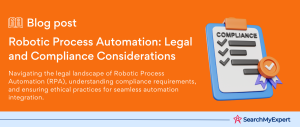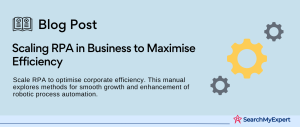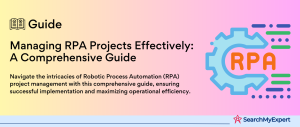Robotic Process Automation and Digital Transformation
In the fast-evolving digital era, businesses continuously seek innovative solutions to stay ahead. Two pivotal elements in this quest are Robotic Process Automation (RPA) and Digital Transformation (DX). Both these technologies are not just buzzwords; they are essential tools in reshaping the future of enterprises.
The Emergence of Robotic Process Automation (RPA)
RPA stands as a beacon of efficiency in the automation world. It involves the use of software robots, or ‘bots’, to automate repetitive, rule-based tasks previously performed by humans. These bots are capable of mimicking a wide range of human-computer interactions, enhancing operational efficiency, reducing errors, and freeing human employees to engage in more complex, value-added activities.
Digital Transformation (DX) – The Business Revolution
Digital Transformation goes beyond mere digitization. It’s a holistic change, integrating digital technology into all areas of a business, fundamentally changing how it operates and delivers value to customers. It’s about evolving with disruptive technologies, reshaping business models, and embracing a digital culture that fosters innovation and agility.
The Symbiosis of RPA and DX
The real magic happens when RPA and DX converge. This synergy can significantly streamline business processes, leading to enhanced efficiency, reduced costs, and improved customer experiences. Implementing RPA within the broader scope of digital transformation initiatives creates a powerhouse of productivity and innovation.
Understanding RPA
Robotic Process Automation (RPA) represents a transformative force in the realm of business automation. At its core, RPA is about automating mundane and repetitive, rules-based tasks using software robots, thereby freeing human workers to focus on more complex and strategic tasks.
Simplifying RPA
Imagine a virtual workforce of robots, tirelessly performing tasks that humans find monotonous. These software robots can log into applications, enter data, calculate, and complete other tasks just like humans, but with unparalleled speed and accuracy.
Core Functionalities of RPA Tools
- Screen Scraping:
This involves capturing bitmap data from the screen and converting it into meaningful information. It’s essential for integrating with legacy systems that lack APIs. - Data Extraction: RPA bots are adept at extracting data from various sources, including documents, websites, and emails, making them invaluable for data-driven tasks.
- Form Filling:
Bots can automatically fill in forms with data sourced from other applications, significantly reducing the time and effort involved in data entry.
Examples of RPA in Business Processes
RPA’s versatility shines across various business operations. Some common examples include:
- Data Entry: Automating data input tasks to increase efficiency and reduce errors.
- Invoice Processing: Managing the entire lifecycle of invoice processing without human intervention.
- Customer Onboarding:
Streamlining the onboarding process by automating background checks, account setups, and initial communications.
By automating these processes, RPA not only enhances efficiency but also enables businesses to reallocate valuable human resources to more strategic tasks, thus driving growth and innovation.
Demystifying Digital Transformation
Digital Transformation (DX) is more than just a modern-day buzzword. It signifies a profound shift in the way organizations operate, driven by the integration and adoption of digital technology.
Defining Digital Transformation
DX can be thought of as a reimagining of business in the digital age. It’s the process of leveraging technology to radically change how an organization operates and delivers value to its customers. This transformation goes beyond mere automation, encompassing a complete overhaul of business processes, corporate culture, and customer experiences.
Key Drivers of Digital Transformation
- Customer Demands:
In an era where customer expectations are ever-evolving, businesses must adapt to provide personalized, on-demand services. - Technological Advancements:
Breakthroughs in AI, cloud computing, big data, and IoT are fueling DX, offering new opportunities for innovation. - Competitive Pressure: The need to stay relevant and ahead of competitors is a significant catalyst for digital transformation.
Different Aspects of Digital Transformation
- Business Process Optimization: Streamlining operations using digital tools to improve efficiency and effectiveness.
- Data-Driven Decision Making: Utilizing big data and analytics to inform strategic decisions, ensuring they are based on insights and trends.
- Customer Experience Enhancement:
Transforming customer interactions through digital channels to provide seamless, personalized experiences.
Digital Transformation is not just about technology; it’s a strategic, holistic approach that requires cultural and organizational change. By embracing DX, companies can unlock new value and redefine their place in the digital landscape.
RPA as an Enabler of Digital Transformation
Robotic Process Automation (RPA) is not just a standalone technology; it’s a pivotal enabler of Digital Transformation (DX). By integrating RPA into DX initiatives, organizations can significantly enhance their transformation journey.
RPA Supporting DX Initiatives
Accelerating Transformation: RPA speeds up the implementation of DX by automating routine tasks, allowing teams to focus on more strategic aspects of transformation.
Bridging the Gap: RPA serves as a bridge between existing legacy systems and new digital solutions, facilitating a smoother transition during digital transformation.
RPA in Larger DX Projects
- Efficiency and Accuracy:
By automating repetitive and time-consuming tasks, RPA ensures greater efficiency and accuracy in DX projects. - Scalability and Flexibility:
RPA offers scalability and flexibility, allowing organizations to adjust quickly as their DX strategy evolves.
Real-World Examples
- Banking Sector:
A leading bank employed RPA to automate its loan processing system. This not only expedited the process but also reduced errors, contributing to a more seamless customer experience. - Healthcare:
A
healthcare provider implemented RPA for managing patient records and appointments, which significantly improved efficiency and patient satisfaction. - Retail:
In retail, RPA was used for inventory management and customer service, enhancing the overall shopping experience and operational efficiency.
These examples underscore RPA’s role as a catalyst in the digital transformation journey, showcasing its potential to revolutionize various industries.
Benefits of Combining RPA and DX
When Robotic Process Automation (RPA) joins forces with Digital Transformation (DX), the result is a powerhouse of efficiency and innovation. Let’s delve into the significant benefits of this powerful combination.
Increased Productivity and Cost Savings
- Streamlining Operations:
RPA and DX together automate processes, leading to a dramatic reduction in time and effort required for routine tasks. This efficiency translates into increased productivity. - Cost Efficiency:
Automation reduces the need for manual labor, resulting in substantial cost savings. A study by Deloitte reported that organizations implementing RPA experienced up to 30% cost savings in the first year.
Improved Accuracy and Compliance
- Error Reduction: RPA minimizes human errors in data entry and processing, leading to more accurate outcomes.
- Regulatory Compliance: Automated processes are consistent and can be programmed to comply with regulatory standards, reducing the risk of non-compliance.
Enhanced Customer Experience
- Personalized Services:
With DX-driven data analytics, businesses can offer personalized experiences. RPA enhances this by efficiently managing large volumes of customer data. - Quick Response Times:
Automation ensures faster response times to customer queries, improving overall customer satisfaction.
Greater Agility and Responsiveness
- Flexibility to Change: The combination of RPA and DX provides organizations with the agility to respond quickly to market changes and customer needs.
- Innovation and Adaptation:
Businesses can innovate and adapt more easily, staying ahead of the competition.
Quantifying the Impact
- Case Study:
A global financial institution reported a 50% reduction in manual work after implementing RPA as part of its DX strategy, leading to a significant improvement in process efficiency. - Data-Driven Results: According to Gartner, companies implementing RPA and DX have seen an average increase of 15% in customer satisfaction.
- Combining RPA and DX not only optimizes business processes but also paves the way for a more agile, customer-centric, and innovative future.
Challenges and Considerations
While the combination of Robotic Process Automation (RPA) and Digital Transformation (DX) offers immense benefits, it also presents certain challenges. Understanding and addressing these challenges is crucial for a successful implementation.
Change Management and Employee Resistance
Understanding the Human Factor: Introducing new technologies can lead to apprehension and resistance among employees.
Strategies to Overcome:
- Effective Communication: Clearly communicate the benefits and changes that RPA and DX will bring.
- Training and Education:
Offer comprehensive training to help employees adapt to the new technology.
Data Security and Privacy Concerns
The Challenge: With the increase in digital data processing, ensuring data security and privacy becomes more complex.
Strategies to Overcome:
- Robust Security Measures:
Implement advanced security protocols and regular audits. - Data Privacy Compliance: Ensure that RPA tools and DX strategies comply with data protection laws.
Investment Costs and ROI
Balancing Cost and Benefit: The initial investment in RPA and DX can be substantial, and organizations may be concerned about the return on investment.
Strategies to Overcome:
- Phased Implementation: Start with small-scale implementations and gradually scale up.
- ROI Analysis: Conduct a thorough return on investment analysis to justify the costs.
Practical Tips for Successful Implementation
- Develop a Clear Strategy: Have a well-defined roadmap for RPA and DX implementation.
- Choose the Right Tools:
Select RPA and digital transformation tools that align with your business
objectives. - Continuous Monitoring and Improvement: Regularly monitor the performance and impact of RPA and DX, and make adjustments as needed.
Addressing these challenges with a strategic approach can pave the way for a smooth and successful integration of RPA and DX
Future Outlook
As we explore Robotic Process Automation (RPA) and Digital Transformation (DX), it’s clear that these technologies are not just fleeting trends but fundamental drivers of modern business evolution.
Key Takeaways
- Synergy of RPA and DX:
The combination of RPA and DX is revolutionizing businesses, enhancing efficiency, accuracy, and customer satisfaction. - Benefits Across Industries:
From banking to healthcare, various sectors are reaping the benefits of RPA and DX, showcasing their versatility and transformative potential. - Overcoming Challenges:
While challenges exist, strategic planning and implementation can effectively mitigate them, paving the way for successful integration.
Transformative Potential
The integration of RPA and DX is not just an operational upgrade; it’s a transformational journey. This synergy is enabling businesses to not only optimize their current processes but also to innovate and adapt to future challenges and opportunities.
Looking Ahead: Future Trends and Advancements
- Advancements in AI and Machine Learning:
These technologies will further enhance RPA, making bots more intelligent and adaptable. - Integration with Emerging Technologies:
RPA and DX will increasingly converge with other technologies like IoT and blockchain, opening new avenues for innovation. - Focus on Strategic Implementation:
Businesses will focus more on strategic implementations of RPA and DX, ensuring they align with long-term goals.
The future of RPA and DX is not just about technological advancement; it’s about reshaping the business landscape, fostering a culture of innovation, and driving sustainable growth.
Conclusion
Robotic Process Automation (RPA) and Digital Transformation (DX) together mark a pivotal shift in the business landscape. This powerful combination enhances efficiency, accuracy, and customer experience, while also offering cost savings and improved compliance. Although challenges like change management and data security arise, strategic planning and adoption of best practices ensure successful integration. As we look to the future, the continued evolution of these technologies promises even greater innovation and business transformation, solidifying their role as key drivers in the modern digital era.
Build a smarter business with Robotic Process Automation Service Companies.
Further Reading
Table of Contents
Toggle






